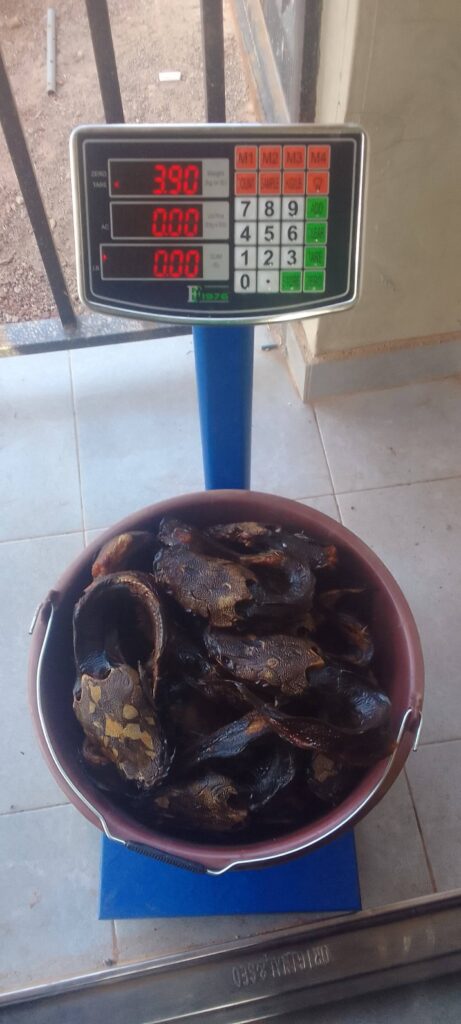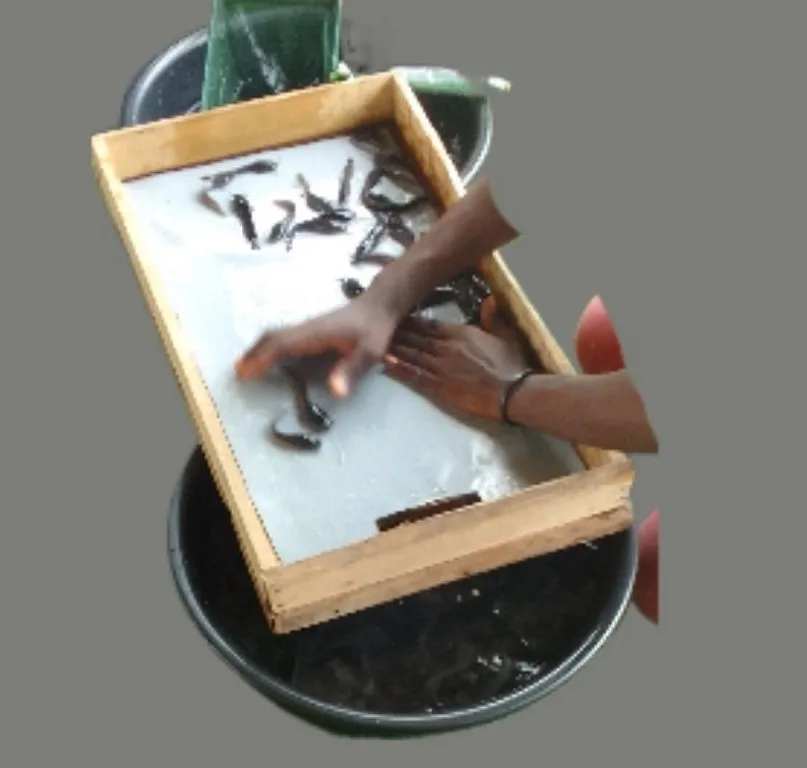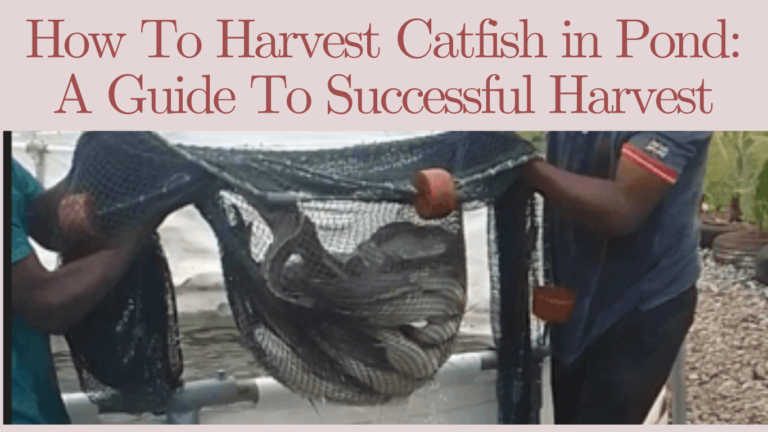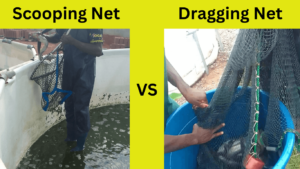How to harvest catfish is the first question every catfish farmer who is a beginner will ask after successfully rearing catfish to maturity. The fish farming journey, from pond preparation all the way to harvest is tedious. Therefore every catfish farmer must learn how to harvest catfish to make maximum profit on their farm.
In this simple guide, we have taken you through how to harvest catfish starting from preparation before harvest, during harvest, and post-harvest. Read to the end and get the utmost benefit.
Pre-harvest (reparation Before Harvest)
Before you learn how to harvest catfish, you need to know the activities that shall be undertaken before your fish reach that maturity stage for harvest. Below are some of the activities to consider before;
1. Assessing Fish Maturity
Before harvesting your catfish, it’s essential to assess their maturity to ensure they’ve reached the optimal size for the market. Catfish typically reach marketable size within 12 to 18 months from hatching to maturity. Depending on factors such as species, water temperature, and feed quality. Here’s how to assess fish maturity:
– Size: Catfish are generally ready for harvest when they reach a size of 1 to 2 Kilograms (Kg), depending on market demand and preferences. That is the range most fish farmers market their harvest their fish.
– Age: Catfish are typically ready for harvest between 9 to 12 months for fingerlings and 12 to 18 months for larger sizes.
The average month duration from fingerling to harvest is 6 months. You can keep them for more or less months depending on the market demand and your preference of you as a farmer.
2. Monitoring Water Quality
Maintaining optimal water quality is crucial for the health and growth of your catfish. Poor water quality can lead to stress, disease outbreaks, and reduced growth rates.
Regularly monitor the pH levels, Dissolved Oxygen, Ammonia, and Nitrite levels of the water in your fish pond to ensure optimal growth. This makes it possible to get up to the size you want your fish for the market.
3. Feeding Strategies
Proper nutrition is essential for promoting growth and maximizing the yield of your catfish. Implementing high-quality feeding methods with appropriate protein and nutrient content can increase fish growth.
Also, implement the right feeding schedule based on nutritional requirements and finally ensure the right Feed Conversion Ratio (FCR) to monitor and ensure efficient feed utilization and minimal feed waste.
4. Disease Prevention
Preventing disease outbreaks is crucial for ensuring the health and well-being of your catfish population. Implement the following disease prevention measures:
– Biosecurity: Implement biosecurity measures to prevent the introduction and spread of pathogens in your fish pond, such as limiting access to unauthorized personnel and disinfecting equipment.
– Vaccination: Consider vaccinating your catfish against common pathogens to reduce the risk of disease outbreaks.
– Regular Health Checks: Conduct regular health checks to monitor the overall condition of your catfish and identify any signs of illness or stress early on.
5. Stocking Density
Maintaining the appropriate stocking density is essential for preventing overcrowding and ensuring optimal growth rates. Consider the following factors when determining stocking density:
– Pond Size: Calculate the maximum stocking density based on the size and water volume of your fish pond to prevent overcrowding.
– Species and Growth Rate: Consider the growth rate and behavior of the catfish species you’re raising when determining stocking density to avoid stunted growth and competition for resources.
Because you need to ensure that the size of the fish is up to marketable size.
During Harvesting
1. Reduce Water Levels
Before initiating the harvest process, it’s important to reduce the water levels in your pond to facilitate easier access to the fish.
Begin by gradually lowering the water level using the pond outlet or pump. Be mindful not to stress the fish or disrupt the pond’s ecosystem. Aim to lower the water level to a depth that allows for efficient fish retrieval without compromising the well-being of the remaining fish.
And if you intend to take all the fish, you may drain all the water leaving just small or nothing left for easy harvest.
2. Selecting Harvesting Tools
Choosing the right harvesting tools is paramount to ensure a smooth and efficient harvest process. Consider the following equipment when learning how to harvest catfish.
– Dip Nets, also known as Scooping Net: Ideal for capturing individual catfish, dip nets are versatile and easy to maneuver in shallow waters. This can be easily used by one person to capture fish.

scooping net or Dip net
– Seine Nets, also known as Dragging Net: Suitable for capturing larger quantities of fish, dragging nets are effective for covering larger areas of the pond. It requires more than one person to use to harvest fish. You start from one end and drag to the other end directing the fish towards the net for capturing. You do that till you pull all captured fish outside and release them to a container or tank.

dragging or sein net
Caution: If the fish pond is the tarpaulin type, make sure the net is free from metals in order not to perforate the pond.
– Harvesting Baskets, basins, or Tanks: Use baskets, basins, or tanks to temporarily hold captured fish before transfer to permanent holding facilities. That is if you are to transfer them to a different location.
– weighing Scale: You need to get either a digital scale or a manual scale to measure the harvested fish for your market.

Digital Scale
3. Employing Harvesting Techniques
Once the water levels are lowered, it’s time to commence the harvesting process. Follow these techniques for optimal efficiency
– Systematic Approach: Adopt a systematic approach to ensure thorough coverage of the pond area. Work strategically from one end of the pond to the other, employing nets or baskets to capture fish along the way. Dragging net is perfect for this method.
– Gentle Handling: Handle the catfish with care to minimize stress and injury. Avoid aggressive handling techniques that may cause trauma or damage to the fish’s delicate skin and fins.
4. Transporting Harvested Fish
After harvesting the catfish, it’s essential to transport them promptly to their destination while ensuring their health and well-being. Consider the following guidelines:
– Transfer to Holding Tanks: Immediately transfer the harvested catfish to clean, aerated holding tanks or containers filled with pond water. Adequate aeration is essential to maintain oxygen levels and prevent stress during transportation.
– Temperature Management: Monitor and regulate the temperature of the holding tanks to prevent thermal shock and ensure the comfort of the fish.
– Minimize Handling Stress: Minimize handling stress during transportation by avoiding overcrowding and excessive agitation of the fish. Handle the tanks with care to prevent splashing and turbulence.
Precautions during harvesting
- Do not feed your fish in the yet-to-harvested pond a day before harvesting. This is because the fish are going to go through a lot of stress.
- Start early in the morning when the weather is still cool. This is especially true when the weather conditions in your place are hot.
- Keep the harvested fish in cool and well-oxygenated water.
- Minimize walking through the pond to avoid overstressing and injuring them.
Post-Harvest of Catfish
Upon reaching the destination, it’s time to proceed with post-harvest handling and processing. Follow these steps for optimal results:
Grading and Sorting
Conduct a final round of grading and sorting to separate the catfish according to size and quality. This step is essential for pricing and marketing purposes.
Sort those you will use for breeding if you intend to. Such fish are known as broodstock. They can typically weigh up to 6kg.
You can sort the big fish to hotels and restaurants that use point and point-and-kill systems. The rest can also be sorted for market women known as table size fish. The market women are mostly the biggest buyers because they are usually bought at a lesser price.

sorting or grading board
Processing
Depending on the intended use, process the catfish accordingly, which may include gutting, cleaning, and packaging for sale or further processing.
In order to maximize your profit after harvesting your catfish, you may also add value to your fish. The common way is to smoke your harvested catfish. When you smoke your fish, the price of the smoked fish is obviously higher than the fresh one. Moreso, you are also able to keep your harvested fish for a longer period without it perishing despite not being in the fridge. It also diversifies your market. You can check out how to smoke your catfish here.
Quality Assurance
Implement stringent quality control measures to ensure that only the highest-quality catfish are delivered to consumers. Monitor factors such as freshness, appearance, and odor to maintain product integrity.
Marketing
After harvesting and sorting your fish to respective sizes and purposes, is now time to package and market your fish. Depending on how you want to sell your fish, you can use a physical marketing strategy by contacting potential customers directly. The potential customers include market women, hotels, household consumers, and others.
You may also use digital marketing strategies such as social media marketing. This approach helps you reach more customers than you can reach with a physical approach. This is the approach that helps me a lot in marketing my fish after harvesting.
Conclusion
To ensure successful catfish farming, how to harvest catfish is very important since that is the most exciting part of the journey. It is the period with which you expect payment for your hard work, investment, and suffering. Mastering how to harvest catfish must be your priority and therefore should be prioritized and learned very well. Follow the above recommendations and you are good to go.




Thank you ever so for you postMuch thanks again Really Cool
Very interesting info!Perfect just what I was looking for!?
Good article and right to the point. I don’t know if this is actually the best place to ask but do you folks have any thoughts on where to get
some professional writers? Thx 🙂 Najlepsze escape roomy
[…] – Harvesting is done once the fish reach the desired size. And this depends on the […]
It’s an amazing article for all the online visitors; they will
take benefit from it I am sure.